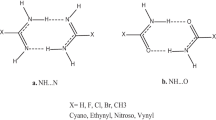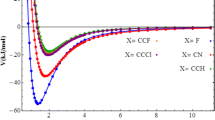Abstract
The intermolecular association of twelve combinations of six different Lewis acids and Lewis bases (i.e., R 3 A–BR′3 where A = B and Al; B = N and P; R = H, F, and C6F5; R′ = H, CH3, and C(CH3)3) was theoretically described by means of DFT calculations using the dispersion-corrected ωB97x-D and B97D functionals in conjunction with the 6-311++G(2d,2p) basis set including toluene as solvent through the PCM-SMD implicit solvent scheme. All the studied Lewis pairs appeared to be stable on the basis of computed BSSE-corrected interaction energies; however, the free energies of formation computed in solution (ΔG solv) indicate that three Lewis acid–base combinations can be considered frustrated Lewis pairs (FLPs). Besides, the four features that characterize FLPs are: (1) large distances between the acid and base centers, (2) negligible changes in the geometry of the acid, (3) weak interaction energies, and (4) non-covalent dispersion energy contributing to almost the entire interaction energy. In the present work, we introduce two ad hoc indexes intended to quantify separately the electronic and steric factors, which have a direct effect in the intermolecular association of Lewis acids and Lewis bases and can be used to distinguished FLPs from classical Lewis adducts. Based on the aforementioned ad hoc indexes, the existence of a new kind of complexes that are “intermediate” between classical complexes and FLPs is proposed.


Similar content being viewed by others
References
Lewis GN (1923) Valence and the structure of atoms and molecules. Chemical Catalogue Company, New York
Brown HC, Schlesinger HI, Cardon SZ (1942) Studies in stereochemistry. I. Steric strains as a factor in the relative stability of some coördination compounds of boron. J Am Chem Soc 64:325–329
Brown HC, Kanner B (1966) Preparation and reactions of 2,6-Di-t-butylpyridine and related hindered bases. A case of steric hindrance toward the proton. J Am Chem Soc 88:986–992
Wittig G, Benz E (1959) Über das Verhalten von Dehydrobenzol gegenüber nucleophilen und elektrophilen Reagenzien. Chem Ber 92:1999–2013
Tochtermann W (1966) Structures and reactions of organic ate-complexes. Angew Chem Int Ed Engl 5:351–371
Welch GC, San Juan RR, Masuda JD, Stephan DW (2006) Reversible, metal-free hydrogen activation. Science 314:1124–1126
Welch GC, Stephan DW (2007) Facile heterolytic cleavage of dihydrogen by phosphines and boranes. J Am Chem Soc 129:1880–1881
Stephan DW, Erker G (2010) Frustrated Lewis pairs: metal-free hydrogen activation and more. Angew Chem Int Ed 49:46–76
Stephan DW (2015) Frustrated Lewis pairs: from concept to catalysis. Acc Chem Res 48:306–316
Stephan DW, Erker G (2014) Frustrated Lewis pair chemistry of carbon, nitrogen and sulfur oxides. Chem Sci 5:2625–2641
Stephan DW, Erker G (2015) Frustrated Lewis pair chemistry: development and perspectives. Angew Chem Int Ed 54:6400–6441
Rokob TA, Hamza A, Stirling A, Soos T, Papai I (2008) Turning frustration into bond activation: a theoretical mechanistic study on heterolytic hydrogen splitting by frustrated Lewis pairs. Angew Chem Int Ed 47:2435–2438
Rokob TA, Hamza A, Papai I (2009) Rationalizing the reactivity of frustrated Lewis pairs: thermodynamics of H2 activation and the role of acid–base properties. J Am Chem Soc 131:10701–11710
Hanza A, Stirling A, Rokob TA, Papai I (2009) Mechanism of hydrogen activation by frustrated Lewis pairs: a molecular orbital approach. Int J Quantum Chem 109:2416–2425
Momming CM, Fromel S, Kehr G, Frohlich R, Grimme S, Erker G (2009) Reactions of an intramolecular frustrated Lewis pair with unsaturated substrates: evidence for a concerted olefin addition reaction. J Am Chem Soc 131:12280–12289
Grimme S, Kruse H, Goerigk L, Erker G (2010) The mechanism of dihydrogen activation by frustrated Lewis pairs revisited. Ang Chem Int Ed 49:1402–1405
Schimmer B, Grimme S (2010) Electric field induced activation of H2-can DFT do the job? Chem Commun 46:7942–7944
Rokob TA, Bako I, Stirling A, Hamza A, Papai I (2013) Reactivity models of hydrogen activation by frustrated Lewis pairs: synergistic electron transfers or polarization by electric field? J Am Chem Soc 135:4425–4437
Zeonjuk LL, Vankova N, Mavrandonakis A, Heine T, Roschenthaler GV, Eicher J (2013) On the mechanism of hydrogen activation by frustrated Lewis pairs. Chem Eur J 19:17413–17424
Skara G, Pinter B, Top J, Geerlings P, De Proft F, De Vleeschouwer F (2015) Conceptual quantum chemical analysis of bonding and noncovalent interactions in the formation of frustrated Lewis pairs. Chem Eur J 21:1–11
Bannwarth C, Hansen A, Grimme S (2015) The association of two “frustrated” Lewis pairs by state-of-the-art quantum chemical methods. Isr J Chem 55:235–242
Ziegler T, Rauk A (1977) On the calculation of bonding energies by the Hartree Fock Slater method. I. The transition state method. Theor Chim Acta 46:1–10
Mitoraj MP, Michalak A, Ziegler T (2009) A combined charge and energy decomposition scheme for bond analysis. J Chem Theor Comp 5:962–975
Johnson ER, Keinan S, Mori-Sánchez P, Contreras-García J, Cohen AJ, Yang W (2010) Revealing noncovalent interactions. J Am Chem Soc 132:6498–6506
Frisch MJ, Trucks GW, Schlegel HB, Scuseria GE, Robb MA, Cheeseman JR, Scalmani G, Barone V, Mennucci B, Petersson GA, Nakatsuji H, Caricato M, Li X, Hratchian HP, Izmaylov AF, Bloino J, Zheng G, Sonnenberg JL, Hada M, Ehara M, Toyota K, Fukuda R, Hasegawa J, Ishida M, Nakajima T, Honda Y, Kitao O, Nakai H, Vreven T, Montgomery JA, Peralta JE, Ogliaro F, Bearpark M, Heyd JJ, Brothers E, Kudin, KN, Staroverov VN, Kobayashi R, Normand J, Raghavachari K, Rendell A, Burant JC, Iyengar SS, Tomasi J, Cossi M, Rega N, Millam JM, Klene M, Knox JE, Cross JB, Bakken V, Adamo C, Jaramillo J, Gomperts R, Stratmann RE, Yazyev O, Austin AJ, Cammi R, Pomelli C, Ochterski JW, Martin RL, Morokuma K, Zakrzewski VG, Voth GA, Salvador P, Dannenberg JJ, Dapprich S, Daniels AD, Farkas Ö, Foresman JB, Ortiz JV, Cioslowski J, Fox DJ (2009) Gaussian 09, Revision C.01. Gaussian, Inc., Wallingford, CT
Chai J-D, Head-Gordon M (2008) Systematic optimization of long-range corrected hybrid density functionals. J Chem Phys 128:084106
Chai J-D, Head-Gordon M (2008) Long-range corrected hybrid density functionals with damped atom–atom dispersion corrections. Phys Chem Chem Phys 10:6615–6620
Grimme S (2006) Semiempirical GGA-type density functional constructed with a long-range dispersion correction. J Comp Chem 27:1787–1799
Raghavachari K, Binkley JS, Seeger R, Pople JA (1980) Self-consistent molecular orbital methods. 20. Basis set for correlated wave-functions. J Chem Phys 72:650–654
McLean AD, Chandler GS (1980) Contracted Gaussian-basis sets for molecular calculations. 1. 2nd row atoms, Z = 11–18. J Chem Phys 72:5639–5648
Frisch MJ, Pople JA, Binkley JS (1984) Self-consistent molecular orbital methods. 25. Supplementary functions for Gaussian basis sets. J Chem Phys 80:3265–3269
Schelegel HB (1987) Optimization of equilibrium geometries and transition structures. Adv Chem Phys 67:249–286
Boys SF, Bernardi F (1970) Calculation of small molecular interactions by differences of separate total energies—some procedures with reduced errors. Mol Phys 19:553–566
Tomasi J, Mennucci B, Cammi R (2005) Quantum mechanical continuum solvation models. Chem Rev 105:2999–3093
Scalmani G, Frisch MJ (2010) Continuous surface charge polarizable continuum models of solvation. I. General formalism. J Chem Phys 132:114110
Marenich AV, Cramer CJ, Truhlar DG (2009) Universal solvation model based on solute electron density and a continuum model of the solvent defined by the bulk dielectric constant and atomic surface tensions. J Phys Chem B 113:6378–6396
Bader RFW (1990) Atoms in molecules: a quantum theory. Oxford University Press, Oxford
Biegler-Koning FW, Bader RFW, Tang TH (1982) Calculation of the average properties of atoms in molecules. II. J Comp Chem 3:317–328
Available from http://www.chemistry.mcmaster.ca/aimpac
Liu S (2007) Steric effects: a quantitative description from density functional theory. J Chem Phys 126:244103
Rong C, Lu T, Liu S (2014) Dissecting molecular descriptors into atomic contributions in density functional reactivity theory. J Chem Phys 140:024109
Fang D, Piquelman JP, Liu S, Cisneros GA (2014) DFT-steric-based energy decomposition analysis of intermolecular interactions. Theor Chem Acc 133:1484
Rincon L, Almeida R (2012) Is the Hammett’s constant free of steric effects? J Phys Chem A 116:7323–7530
Haaland A (1989) Covalent versus dative bonds to main group metals, a useful distinction. Angew Chem Int Ed Eng 28:992–1007
Gilbert TM (2004) Tests of the MP2 model and various DFT models in predicting the structures and B–N bond dissociation energies of amine-boranes (X3C)mH3−mB–N(CH3)nH3−n (X = H, F; m = 0–3; n = 0,3): Poor performance of the B3LYP approach for dative B–N bonds. J Phys Chem A 108:2550–2554
Wagner JP, Schreiner PR (2015) London dispersion in molecular chemistry-reconsidering steric effects. Angew Chem Int Ed Eng 54:12274–12296
Kocman M, Jurecka P, Dubecky M, Otyepka M, Cho Y, Kim KS (2015) Choosing a density functional for modeling adsorptive hydrogen storage: reference quantum mechanical calculations and a comparison of dispersion-corrected density functionals. Phys Chem Chem Phys 17:6423–6432
Changrakumar KRS, Pal S (2002) A systematic study on the reactivity of Lewis acid–base complexes through the local hard-soft acid–base principle. J Phys Chem A 106:11775–11781
Pinter B, Fievez T, Bickelhaupt FM, Geerlings P, De Proft F (2012) On the origin of the steric effect. Phys Chem Chem Phys 14:9846–9854
Slater JC (1965) Quantum theory of molecules and solids. McGraw-Hill, New York
Chermette H (1999) Chemical reactivity indexes in density functional theory. J Comp Chem 20:129–154
Acknowledgments
This work has been performed by employing the resources of the USFQ’s High Performance Computing system (HPC-USFQ). The authors would like to thank USFQ’s chancellor and collaboration grants program for financial support.
Author information
Authors and Affiliations
Corresponding author
Additional information
Published as part of the special collection of articles “CHITEL 2015 - Torino - Italy.”
Rights and permissions
About this article
Cite this article
Becerra, M., Real-Enriquez, M., Espinosa-Gavilanes, C. et al. On the thermodynamic stability of the intermolecular association between Lewis acids and Lewis bases: a DFT study. Theor Chem Acc 135, 77 (2016). https://doi.org/10.1007/s00214-016-1829-5
Received:
Accepted:
Published:
DOI: https://doi.org/10.1007/s00214-016-1829-5




